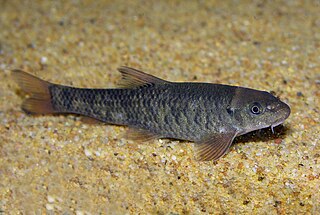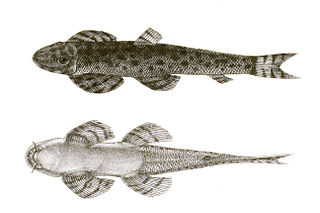
Cypriniformes is an order of ray-finned fish, which includes many families and genera of cyprinid fish, such as barbs, gobies, loaches, botias, and minnows. Cypriniformes is an "order-within-an-order", placed under the superorder Ostariophysi—which is also made up of cyprinid, ostariophysin fishes. The order contains 11–12 families, over 400 genera, and more than 4,250 named species; new species are regularly described, and new genera are recognized frequently. Cyprinids are most diverse in South and Southeast Asia, but are entirely absent from Australia and South America. At 112 years old, the longest-lived cypriniform fish documented is the bigmouth buffalo.

The hillstream loaches or river loaches are a family, the Balitoridae, of small fish from South, Southeast and East Asia. The family includes about 202 species. They are sometimes sold as "lizardfish" or "flossensaugers". Many of the species are popular for aquaria, species in the genus Sewellia are most commonly sold in the aquaria trade. They have a number of similarities with the Cobitidae, their sibling family of "loaches", such as multiple barbels around the mouth. They should not be confused with the loricariids, which look similar but are a family of catfish.

Garra is a genus of fish in the family Cyprinidae. These fish are one example of the "log suckers", sucker-mouthed barbs and other cyprinids commonly kept in aquaria to keep down algae. The doctor fish of Anatolia and the Middle East belongs in this genus. The majority of the more than 160 species of garras are native to Asia, but about one-fifth of the species are from Africa.

Schistura is a genus of fish in the stone loach family Nemacheilidae native to the streams and rivers of the southern and eastern Asia. Some of these species are troglobitic.
Sinogastromyzon is a genus of hillstream loaches native to eastern Asia.
Maurice Kottelat is a Swiss ichthyologist specializing in Eurasian freshwater fishes.
Hemimyzon ecdyonuroides is a species of hillstream loach in the genus Hemimyzon. It is known from two tributaries of the Mekong, from Sekong River and Sesan River drainages in Vietnam and Laos.

Balitora is a genus of ray-finned fishes in the family Balitoridae endemic to Asia.

Loaches are ray-finned fish of the suborder Cobitoidei. They are freshwater, benthic (bottom-dwelling) fish found in rivers and creeks throughout Eurasia and northern Africa. Loaches are among the most diverse groups of fish; the 1249 known species of Cobitoidei comprise about 107 genera divided among 9 families.
Homatula is a genus of stone loaches endemic to China.
Katibasia is a monospecific genus of freshwater ray-finned fish belonging to the family Gastromyzontidae, a group which shares the common name hillstream loaches with the family Balitoridae. The only species in the genus is Katibasia insidiosa, a species of loach which is endemic to Sarawak, Eastern Malaysia.
Liniparhomaloptera is a genus of fish in the family Gastromyzontidae found in China and Vietnam.
Paracobitis is a genus of Asian stone loaches.
Paraschistura is a genus of stone loaches most of which occur in Central, South and Western Asia.
Physoschistura is a genus of fish in the family Nemacheilidae found mostly in Southeast Asia.

The Nemacheilidae, or stone loaches, are a family of cypriniform fishes that inhabit stream environments, mostly in Eurasia, with one genus, Afronemacheilus found in Africa. The family includes about 790 species.
Yaoshina is a monospecific genus of freshwater ray-finned fish belonging to the family Gastromyzontidae, commonly called the hillstream loaches, although this also refers to the loaches in the family Balitoridae. The only species in the genus is Yaoshania pachychilus, the panda loach. A loach which is endemic to mountain streams in Jinxiu County, Guangxi in China. This species grows to a length of 5.8 centimetres (2.3 in) SL. This species is monotypic, but it was formerly included in Protomyzon. Juveniles are strikingly coloured in black-and-white, but adults are relatively plain. Y. pachychilus quickly became a popular aquarium fish in the 2010s.

Balitoropsis also known as the lizard loaches is a genus of hillstream loaches native to eastern Asia.
Sewellia hypsicrateae is a species of fish in the genus Sewellia. The fish was first described in the Dakrong River in 2016.
Sewellia monolobata is a species of freshwater ray-finned fish belonging to the family Gastromyzontidae, commonly called the hillstream loaches, although this also refers to the loaches in the family Balitoridae. This loach is found in the Thu Bon River drainage, Quang Nam Province in Vietnam.








